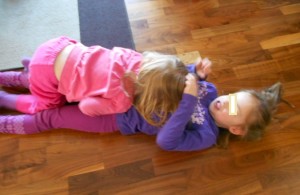 Not as controversial as weapons play, big body or rough and tumble play is often discouraged by parents, especially in the house. The wrestling, jumping, chasing, tumbling, racing, rolling and other play can get pretty loud even in a big place. But, little bodies seem to play like this naturally and it’s part of early learning and healthy development.
Not as controversial as weapons play, big body or rough and tumble play is often discouraged by parents, especially in the house. The wrestling, jumping, chasing, tumbling, racing, rolling and other play can get pretty loud even in a big place. But, little bodies seem to play like this naturally and it’s part of early learning and healthy development.
Rough-housing is more common with dads than with moms. Mariana Brussoni from the Department of Pediatrics at UBC explains why this is so and why this play is so important, despite the risks:
“…I consider risky play an injury prevention strategy. Risky play, including roughhousing, provides children with important developmental and physical benefits. Children who have the opportunity to engage with risks in a secure setting with minimal hazards and appropriate supervision learn lessons that will serve them in good stead when they encounter risks in the “real” world.”
“…Compared to mothers, fathers spend a larger percentage of their time playing with their children. Men’s approach to caring involves doing activities together and taking kids out to play.”
(KIds benefit from rough and tumble play with dads, UBC News, June 10, 2014)
Besides parents or other adults, brothers and sisters are often included. While some children, both boys and girls, seem to crave this sort of play, others are not as interested. Engaging in big body play stimulates social and emotional learning as well as language and communication. During rough play, children learn to listen and watch others for clues so they can play without hurting. Kids practice problem solving and other creative thinking skills. All of these are important for early learning and for interacting.
Of course, rowdy play needs careful supervision by adults and some reasonable rules for safety, such as no means no and making sure the space is clear. Sometimes, a time limit is helpful. How do you handle big body play at your house?
